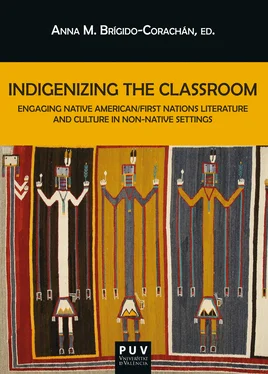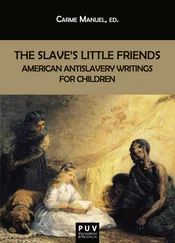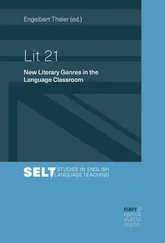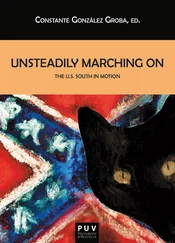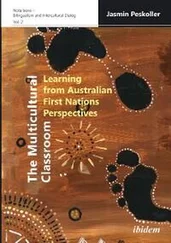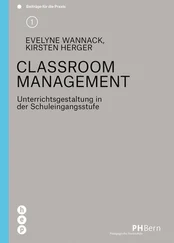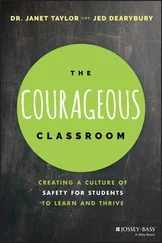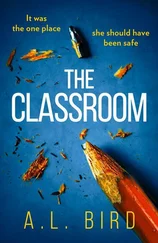By the time we get to Gordon Henry Jr.’s The Light People , the penultimate text read in the most recent iteration of the course, students have come together in an engagement in the history of White Earth, traditional cultural practices and contemporary issues, and matters of sovereignty. With The Light People our engagement culminates in and with the text’s appropriation in its last section, by far the longest of the novel, of the opening phrase of the Constitution of the United States in order to have it sound and resound in the service of another nation and people: White Earth and the White Earth Anishinaabeg. There, Oskinaway, back home to the Fineday reservation, a fictionalized White Earth, after his efforts to heal an injured bird led him to neglect his studies and fail his veterinarian school courses, attempts to engage the bird’s mind while its wing heals. Moved by an ad, he buys an audio program designed to get birds to talk via recordings of the Preamble of the U. S. Constitution broken into words and phrases and accompanied by a European largo of stringed instruments ( The Light People 200). All the bird is able to learn and recite, however, is the opening phrase, “We the People,” because, it turns out, the program is a scam.
Reflecting on the meeting at which the people of Fineday learned of and decided how to deal with the crisis of their vanishing children, Oskinaway, we read, “felt the power of the unity of community decision still living in him” ( The Light People 223) as he arrives home at the novel’s end, saves the bird from choking to death, and then, as it is now clearly capable of flight, releases the bird and watches it glide over the treeline and disappear. From his bed, between sleeping and waking, he hears, away in the distance and its source out of sight, “We the people, we the people, we the people, we the people” ( The Light People 226). Oskinaway would carry that experience and those words with him throughout his life, hearing them and speaking them; so too should the students, recognizing that they reference the Anishinaabeg, yes, and more generally, the Indigenous peoples of North America, and beyond. This need not be an either/or construction, mind you, either the United States or White Earth, either Euroamerica or Native America, but a both-and construction wherein the latter functions as a supplement, undoing the country as nation in order that, another way forward might be imagined and created.
That other way forward, an Indigenous way that we be prepared to follow once freed from the hold of stereotypes, is rooted in particulars of place and community. Cree/Dene artist and scholar Jarrett Martineau and his co-author Eric Ritskes begin their essay “Fugitive indigeneity: Reclaiming the terrain of decolonial struggle through Indigenous art” with a simple, stark proclamation: “Indigenous art is inherently political” (I). For them, Indigenous art is much more than simply a response to and/or taking a distance from the majority society and its dominant ideology. Rather, because Indigenous art is tethered to land and community, and vice-versa, it should be seen as particular “localized sites of creative engagement” that are rooted in place and the quotidian, the lived experiences of Native people (II). Martineau and Ritskes would have scholars “re-center Indigenous land, communities, and cultures as the force that energizes decolonization and provides fugitive possibilities for movement and creative expression” (II).
We find instances of just such localized creative engagement in Blaeser’s poetry, with which the course ends as we effectively inscribe a circle that is the opposite of the containing and constraining enclosure that is the stereotype indian . The prose poem “Studies for Migration” from Absentee Indians and Other Poems , for example, begins with an echo of the beginning of “Living History” from Trailing You , “Pulled into Joe Olson’s landing” ( Absentee Indians 30). It is a fitting and powerful opening, indicating both that one enters and that one is drawn into a place. Moreover, the plural pronoun at play in the poem makes clear that the place has this effect on more than just the narrator. So people return: “Each year someone comes home” (30) the second stanza begins, Pat next to her father, Von on his grandma’s old land, Laurie back as well. The land is waiting for them, “Each space held for years in stories” (30) the poem tells us; it tells us, too, that “Clouded titles fill courthouse files” (30), a stark reminder of how so much of White Earth land was taken from the people. Still, maple sap runs in the spring, sugarbushing connects people to place, place to people, people to each other, as does ricing, powwowing, kitchentable cribbage. In recognition and in the spirit of connection, the poem’s short final stanza opens with a conjunction: “And flight the birds could tell us is a pattern. Going. And coming back” (30).
Trumpeters come back; so too pelicans, “filtering in for seven summers. Today they fill the north quarter of South Twin. The evening lake black with birds” (30). Likely they can be seen from Pinehurst. It is not just birds. Sturgeon are back at White Earth now, have been for several years. As is true of migratory birds, sturgeon range widely; theirs is continental liberty, or so it should be, but it took dam modification and dam removal by the state to enable the fish to swim in and through White Earth waters again as they once had and should.
Theorizing, teaching, Native American literatures, world literature, the world: again, the stakes are so very high. Early on, I asked you to “bear with me,” the phrase a conscious invocation of Vizenor and specifically the “Letter to the Reader” in his first novel, Bearheart: the Heirship Chronicles . One of the Anishinaabe clans dedicated to defense, to have the bear with me, as with Vizenor, is to signal that people and place are threatened and must be defended. Understanding and appreciating the connection between Indigenous people and place is critical to an understanding of their literature. What holds for the White Earth Anishinaabeg and White Earth holds for other Natives and their traditional homeland, as well.
The bear is with me because this is no laughing matter. Spivak closes Death of a Discipline with a call for planetarity; acknowledging that “The planetarity of which I have been speaking in these pages is perhaps best imagined from the precapitalist cultures of the planet” (101) and that “The ‘planet’ is here, as perhaps always, a catachresis for inscribing collective responsibility” ( Death of a Discipline 102). 6 Blaeser too ends with a recognition and celebration of Native literary artists from across the continent, using phrases from their works, the first being Gordon Henry Jr.’s “ outside White Earth ,” as part of her articulation of what it means to be a “Y2K Indian” “ writing the circle / of return ” ( Absentee Indians 131). A pantribal nations collective of voices, resounding.
Shared voices, shared responsibility. A world literature committed to the world, to the earth and all living things. Imagine that. Trumpeter and pelican, sturgeon and bear; the species fittingly correspond to the Anishinaabe clans traditionally associated with leadership, teaching, and defense. Imagine this: we use our position as leaders to teach students such that they learn what Indigenous literatures reveal about our shared responsibility, and that we and they act in defense of the earth, of the human and the more-than-human, each and every one. That is a story worth telling, worth sharing.
Works Cited
Blaeser, Kimberly. Absentee Indians and Other Poems . Michigan State University Press, 2004.
Читать дальше
